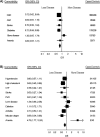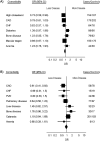Chronic disease in men with newly diagnosed cancer: a nested case-control study
- PMID: 20603278
- PMCID: PMC2917057
- DOI: 10.1093/aje/kwq127
Chronic disease in men with newly diagnosed cancer: a nested case-control study
Abstract
The authors performed a matched case-control study (1982-2007) nested in a prospective cohort of 22,071 US men to determine the prevalence of chronic diseases of aging in those with newly diagnosed cancer. They matched one control by age to each of 5,622 men who developed cancer over the 25 years of follow-up, as of the date of cancer diagnosis. A modified Charlson score was calculated that reflected comorbidities prior to the matching date, and the authors used conditional logistic regression to determine the odds ratios of various diseases. No substantial differences were found between the scores of cases and controls overall, by cancer subtype, or by age at diagnosis. Overall, men who developed cancer were less likely to have had hypercholesterolemia (odds ratio (OR) = 0.79, 95% confidence interval (CI): 0.72, 0.87) or coronary artery disease (OR = 0.85, 95% CI: 0.77, 0.96). Compared with controls, men with cancers for which there is routine screening had fewer diseases, whereas those with smoking-related cancers had more. Prostate cancer was inversely associated with both coronary artery disease (OR = 0.72, 95% CI: 0.62, 0.84) and diabetes (OR = 0.72, 95% CI: 0.58, 0.89). Overall, men who developed cancer had no more comorbidity or frequent history of chronic disease than their age-matched controls.
Figures




Comment in
-
Re: "Chronic disease in men with newly diagnosed cancer: a nested case-control study".Am J Epidemiol. 2010 Dec 1;172(11):1334. doi: 10.1093/aje/kwq343. Epub 2010 Oct 22. Am J Epidemiol. 2010. PMID: 20971794 No abstract available.
References
-
- The top 10 causes of death. Geneva, Switzerland: World Health Organization; 2008. (Fact sheet 310). ( http://www.who.int/mediacentre/factsheets/fs310_2008.pdf)
-
- Hewitt M, Rowland JH, Yancik R. Cancer survivors in the United States: age, health, and disability. J Gerontol A Biol Sci Med Sci. 2003;58(1):82–91. - PubMed
-
- Zeber JE, Copeland LA, Hosek BJ, et al. Cancer rates, medical comorbidities, and treatment modalities in the oldest patients. Crit Rev Oncol Hematol. 2008;67(3):237–242. - PubMed
Publication types
MeSH terms
Substances
Grants and funding
LinkOut - more resources
Full Text Sources
Medical

